
Header image: Allen Pleus (WDFW)
June 22, 2017
Four European green crab were captured at Dungeness Spit in early April – the third location in inland Washington where green crab have been found. Since the initial discovery 10 weeks ago, staff and volunteers from US Fish and Wildlife Service (USFWS) and Washington Department of Fish & Wildlife personnel (WDFW) have been conducting intensive trapping and removal efforts in this newly-uncovered population. To date, 76 live green crab have been removed from the area (total effort of more than 2,100 trap sets). Unfortunately, this contrasts greatly from the finds at both of the other sites in Washington’s Salish Sea. The first detections were made in Westcott Bay (San Juan Island) and Padilla Bay (near Anacortes) late last summer, with very few additional individuals found during subsequent trapping efforts. Dungeness Spit has a much greater density of crab than either of the other two areas, heightening the need for aggressive trapping and removal efforts to reduce the chance that the population could become a permanent fixture in the area.
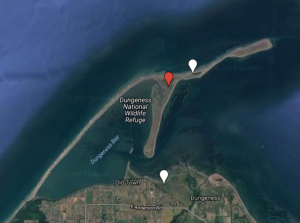
Crab Team sites surrounding Dungeness Bay. The two northern sites on Dungeness Spit are monitored by USFWS, while the southern site near Dungeness Landing park is monitored by Crab Team volunteers. The site marked in red is the location where European green crab have been captured. None have been found at either of the other two sites.
The initial capture of four crabs occurred on April 12, as part of regular, monthly Crab Team monitoring efforts. USFWS has been trapping for green crab in the refuge for more than a decade and joined Crab Team monitoring this year. In consultation with Crab Team staff, UWFWS moved their two monitoring sites slightly to more precisely target the type of habitat green crab appear to favor in our region. As part of their first sampling effort in April, volunteers and staff found the four crabs in traps at one of the two sites, in a marsh channel on Graveyard Spit, which is an offshoot of Dungeness Spit. In partnership with WDFW, and supported by advice from Crab Team, USFWS dramatically increased the number of traps set to remove as many crabs as possible. Crabs are primarily being captured in baited traps, though a few crabs have been nabbed by hand by monitors with eagle eyes (and heron speed!).
What do we know so far?
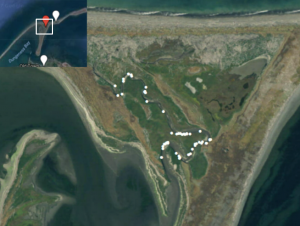
Though traps have been set widely at Graveyard Spit, green crab have only been captured in a single marsh channel (white dots). Click to enlarge.
- Green crab in Dungeness Bay are only being found in the marsh channel at Graveyard Spit. Trapping in nearby habitat at the National Wildlife Refuge indicates that green crabs are most likely restricted to this single 550 meter-long channel. This is good news because it allows trapping to be concentrated in a relatively small, and tractable area.
- Green crab in Dungeness Bay are young, but growing. The size of the crabs captured so far ranges from 26mm – 62mm across the back shell (about 1” – 2.5”). Based on how fast we know crabs grow, we can tell that this is a relatively new population, and likely arrived at Dungeness Spit during 2016. The wide range of sizes could reflect the fact that a female green crab can release multiple broods per year in Pacific Northwest, where our temperate climate allows a longer growing season for this species than is seen in other parts of the world.
- Green crab in Dungeness Bay have the potential to establish a new source population. Whereas at the other two locations where few green crab found have been scattered over large distances, at Dungeness Spit, green crab are consistently being captured at the same location. Finding even a few each week in one location typically means that a number more are still hiding in the mud. Given that crabs likely arrived in 2016, they would have had fairly limited opportunity to reproduce locally. But springtime is an amorous time for green crab, which are molting in preparation for mating. If they reproduce, they could be a new local source of larvae to get further into the Salish Sea.
- We hit a critical window for trapping and removing crabs from the population. As green crab get into their reproductive time of year, they stop coming to traps and start making more green crab – a double whammy for control efforts. The quick action to get traps in the water was imperative to interrupt this cycle and remove as many crabs as possible before they multiply.
What more do we want to learn?
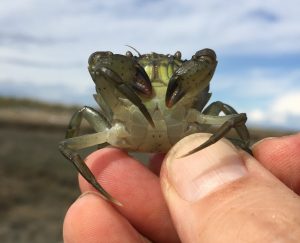
Small male European green crab captured as part of removal trapping at Graveyard Spit. (Photo: Allen Pleus WDFW).
- Where did these green crab come from? Given that humans have relatively little presence on Graveyard Spit, the most likely explanation for how green crab arrived there is that they floated in as larvae from another infested area. In biological invasions, we often consider the closest known population as a potential source, which in this case is Sooke Basin, BC, just west of Victoria, where green crab were first observed in 2012. The following year, surveys by Canada’s Department of Fisheries and Oceans (DFO) indicated Sooke Basin harbored the only population on the Canadian side of the Salish Sea. This makes it a likely source for the green crab now found at Dungeness Spit. However, it’s also possible that these crabs came from one of the coastal populations, either in BC, Washington (green crab have been present periodically in Willapa Bay and Grays Harbor since 1998), Oregon, or California (the first known, and best-established population on the US West Coast). Crab Team is retrieving samples of the crabs caught at Dungeness Spit to conduct genetic analysis, in an effort to determine the source of green crab. This work will take several months, but hopefully will help us find out if crabs are coming from Canada, coastal Washington, Oregon or California, or even somewhere else in the world.
- Are green crab hiding out at other sites in the region? If green crab did float into Dungeness Bay as larvae, the same cloud of larvae probably also floated past, and might have gotten washed into, other spots that could also be good green crab habitat. We want to know if there are any other populations of green crab hiding out in some of those areas where we haven’t yet had a chance to look. Thankfully, compared to regions further into Puget Sound, there isn’t as much good low-energy habitat for green crab on the Strait of Juan de Fuca as there is further into Puget Sound. The goal will be to target these areas for exploratory trapping, where we set a high density of traps for a few nights. You can get a look at the sites that we believe are the best for green crab on our habitat suitability map. Already Crab Team, WDFW, and partners at the Jamestown S’Klallam Tribe have started to explore these nearby habitats and so far we haven’t turned up any evidence of green crab.
- Can we be effective at stopping population growth? The presence of green crab in Dungeness Bay, though unfortunate, offers a unique opportunity to test how effective the EDRR (Early Detection-Rapid Response) model is for intervening in a potential green crab invasion. Generally speaking, invasive species are rarely noticed in a new spot until they have already become too abundant to eradicate. Though 76 crabs at Dungeness Spit is more than we would ever like to see, the population hasn’t yet reached the numbers that are seen in areas of greatest infestation, and they are, as far as we know, still confined to a relatively small location. Recent efforts in California have shown that very intensive, consistent trapping can have a dramatic impact on populations in isolated locations. At Graveyard Spit, the population seems, so far, to be small and isolated, easier to tackle than if green crab showed up everywhere all at once.
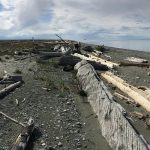
Graveyard Spit is remote and a UTV is required to get gear and people out to set traps. (Photo: Allen Pleus WDFW)
Ongoing trapping will be a critical part of managing green crab in Dungeness Bay. The intensive trapping efforts there continue to bring up a few green crab each week, although after more than two months there are some days where all the traps come up with only native critters in them – a potentially promising sign. As part of a National Wildlife Refuge, Graveyard spit is managed for the benefit of native wildlife, and managers have stated they will try to remove every green crab they can. Trapping, though resource-intensive, is the best tool we at the moment have to control this species. Current plans call for continued intensive trapping throughout the summer. In addition, Crab Team monitoring protocols are still being implemented monthly. Because this is the only Crab Team site where there is an appreciable number of green crab, this information could provide us with the first actual data on what green crab impacts are in our inland seas. We tend to reduce trapping during the winter, because it’s less effective at attracting crabs, during the colder months. But it’s likely that monitoring at Dungeness Spit will be ongoing for some time, as green crab larvae could get washed in again.
Preventing and managing biological invasions is similar to planning for a wildfire season: the best thing to do is prevent either invasions or wildfires from taking hold in the first place, but we know that some will occur despite our best efforts. It’s difficult to forecast exactly where, when, or how severe they will be when they do pop up, and yet it’s imperative to respond quickly and aggressively as soon as they are detected, and while they are still small. Early detection is the foundation of this process, and here we are fortunate to have so many volunteers, partners, and beachgoers as our “lookouts” for any smoldering green crab invasions.
-Emily Grason
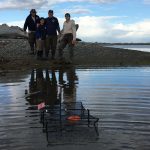
USFWS Volunteers and Deputy Project Lead Lorenz Sollmann (R) at Graveyard Spit. (Photo: Allen Pleus WDFW)
JUN
2017